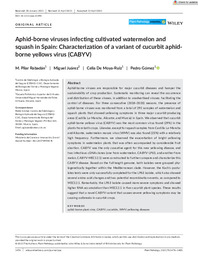Título :
Aphid-borne viruses infecting cultivated watermelon and squash in Spain: Characterization of a variant of cucurbit aphid-borne yellows virus (CABYV) |
Autor :
Rabadán Manzanera, María Pilar
Juárez Gómez, Miguel 
De Moya Ruiz, Celia 
Gómez López, Pedro |
Editor :
Wiley |
Departamento:
Departamentos de la UMH::Producción Vegetal y Microbiología |
Fecha de publicación:
2021 |
URI :
https://hdl.handle.net/11000/30776 |
Resumen :
Aphid-borne viruses are responsible for major cucurbit diseases and hamper the sustainability of crop production. Systematic monitoring can reveal the occurrence and distribution of these viruses, in addition to unadvertised viruses, facilitating the control of diseases. For three consecutive (2018–2020) seasons, the presence of aphid-borne viruses was monitored from a total of 292 samples of watermelon and squash plants that showed yellowing symptoms in three major cucurbit-producing
areas (Castilla La-Mancha, Alicante, and Murcia) in Spain. We observed that cucurbit aphid-borne yellows virus (CABYV) was the most common virus found (29%) in the plants from both crops. Likewise, except for squash samples from Castilla La-Mancha and Alicante, watermelon mosaic virus (WMV) was also found (23%) with a relatively high frequency. Furthermore, we observed the exacerbation of bright yellowing symptoms in watermelon plants that was often accompanied by considerable fruit abortion. CABYV was the only causative agent for this new yellowing disease, and two infectious cDNA clones (one from watermelon, CABYV-LP63, and another from
melon, CABYV-MEC12.1) were constructed to further compare and characterize this CABYV disease. Based on the full-length genome, both isolates were grouped phylogenetically together within the Mediterranean clade. However, the Koch's postulates tests were only successfully completed for the LP63 isolate, which also showed several amino acid changes and two potential recombination events, as compared to MEC12.1. Remarkably, the LP63 isolate caused more severe symptoms and showed higher RNA accumulation than MEC12.1 in five cucurbit plant species. These results suggest that a novel CABYV variant that causes severe yellowing symptoms may be causing outbreaks in cucurbit crops.
|
Palabras clave/Materias:
Aphid-borne plant virus
CABYV
Cucurbits
WMV
Yellowing diseases |
Tipo documento :
application/pdf |
Derechos de acceso:
info:eu-repo/semantics/openAccess
Attribution-NonCommercial-NoDerivatives 4.0 Internacional |
DOI :
https://doi.org/10.1111/ppa.13390 |
Aparece en las colecciones:
Artículos Producción vegetal y microbiología
|
 La licencia se describe como: Atribución-NonComercial-NoDerivada 4.0 Internacional.
La licencia se describe como: Atribución-NonComercial-NoDerivada 4.0 Internacional.
.png)
